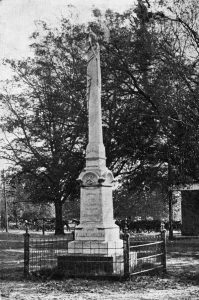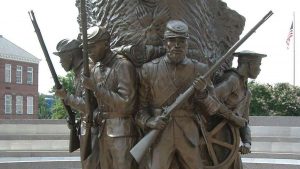For a better future, study the past.
Menu
For a better future, study the past.
Memory can be a funny thing. It changes over time. People change, times change, interpretations change, what we consider important changes.
Nowhere is this more evident than in the field of Civil War memory and monuments. In the years immediately after the war, monuments and memorials were constructed for several different reasons. In some instances, it was to remember and honor those who served and maybe did not return from battle. In the south, these monuments were often meant to recall what those of the time considered a better time. Words carved into granite were chosen with great care as to meaning.

Ladies Memorial Associations and similar groups were often at the head of constructing these memorials; raising funds and dealing with stonemasons to make sure these reminders of the past were exactly what they wanted. Most scholars consider these memorials a key component of Lost Cause mythology.
In the years after the passing of Civil War veterans and their direct descendants, memorial creation has passed to new generations. These newer monuments often have a different, and many times politically charged rhetoric. As memorials, particularly those honoring the Confederate cause, are removed from publicly owned lands; new monuments are usually placed on privately held lands. Historians have often questioned the need or motives for placing new memorials.
The fate of memorials removed from public lands is a thorny one that does not have a clear and easy answer. Many people are against removal of any type of monument, often claiming it is erasing history. On the other side are those who would not just remove what they deem offensive memorials, but they would destroy them, often in a public scene in order to gain attention to their cause.
An often-cited answer is to put them in a museum. It is not as easy as that. Museums have collection policies and goals that Boards of Directors must abide by. Housing a large Civil War monument in usually not in those goals. Space is often a concern. How many museums have room to house a twenty-five foot tall memorial? Are museum facilities structurally able to hold the weight of what might be a several ton piece of granite or a large bronze piece? Finally, who will pay for the moving and exhibit upkeep? Even if a museum can address these concerns, community input is important. Do museum patrons feel owning a Civil War monument is in the best interest of the organization? Finally, again we come to the thorny question, who and how would these pieces be interpreted.
A final concern with any type of public memorial is interpretation and context. Interpretation and context are areas that some of the public do not appreciate. They feel they should be left as is with no attempt to explain what a viewer is witnessing. Also, should monuments to the Confederate cause be placed at government buildings no matter the interpretation.
Some memorials are blatantly obvious what they are trying to achieve. Others are more nuanced with carefully chosen language and symbolism. While maybe not obvious to everyone today, to contemporaries, these monuments were understood in their day.
As stated above, interpretations change. No matter where a monument may be located, it is important today that some level of interpretive work be included to let visitors know the who, what, and why of a monument or memorial. It is then up to the viewer to make a determination what they think. Are these memorials to lost soldiers and family members? Are they memorials to a prior way of life? Are they monuments meant to hurt and intimidate others? Are they a reminder of a way of life we should not allow to be forgotten? Can they be a teaching tool? Are they strictly now a work of art like any other sculpture?

Today, there is increasingly an effort to memorialize those who have been forgotten in the past. This includes memorials to women, those on the home front, and the telling of stories of slavery and African American soldiers. No longer are cities, states, and organizations scared of telling the true horrors of war and what it was like for those outside the sphere of battle. While this movement has not proven universally popular, it is one that will continue, particularly as further scholarship develops these previously unknown stories.
What I have gathered below is a listing of materials related to Civil War monuments, memorials, and memory. These works are often from academic presses and may have a scholarly bent. Some of these titles tackle head on the controversy of Civil War memorials while others are concerned with cataloging memorials by state or battlefield.
While I do own quite a few of these titles, I have not reviewed all of them. If I have included them I feel they are appropriate to the subject and worthy of your consideration.
Please note, the intent of this bibliography is not to take sides or promote an ideology, but rather it is to provide you, the reader, with resources allowing you to better understand the topic. Titles that appear to be intentionally inflammatory are excluded.
I have not yet mined academic journals and other periodicals regarding the subject. I hope to do so in the not too distant future. I will create a separate section on this post for these materials.
Please feel free to reach out to me or leave a comment regarding books I have not listed. Materials dealing with Civil War memorials, groups who erected these memorials, artists and those who created monuments, and related topics are encouraged. If you have read any of these titles, please feel free to leave a comment about the book. An open and respectful dialogue is encouraged.
I will periodically be updating this list based upon reader input and especially as publishers release new titles.
To keep up with all things Civil War including modern interpretation, I strongly recommend subscriptions to Civil War Times and Civil War Monitor. Both offer writing by top notch scholars and have excellent photos and maps.
Allison, David B. Controversial Monuments and Memorials: A Guide for Community Leaders. Lanham: Rowman and Littlefield, 2018.
Andres, Matthew Cenon. Stone Soldiers: Photographing the Civil War Monuments in Illinois. Self Published. 2019.
Brown, Thomas J. Civil War Monuments and the Militarization of America. Chapel Hill: University of North Carolina Press, 2019.
Brown, Thomas J. The Public Art of Civil War Commemoration: A Brief History with Documents. New York: Macmillan Publishers, 2004.
Butler, Douglas J. North Carolina Civil War Monuments: An Illustrated History. Jefferson: McFarland & Co., 2013.
Chevalier, R.N. and Donna Chevalier. Rhode Island Civil War Monuments: A Pictorial Guide. Pawtucket: Stillwater River Publications, 2017.
Cox, Karen L. Dixie’s Daughters: The United Daughters of the Confederacy and the Preservation of Confederate Culture. Gainesville: University Press of Florida, 2019.
Cox, Karen L. No Common Ground: Confederate Monuments and the Ongoing Fight for Racial Justice. Chapel Hill: University of North Carolina Press, 2021.
Domby, Adam. The False Cause: Fraud, Fabrication, and White Supremacy in Confederate Memory. Charlottesville: University of Virginia Press, 2022.
Foster, Gaines M. Ghosts of the Confederacy: Defeat, the Lost Cause, and the Emergence of the New South, 1865-1913. New York: Oxford University Press, 1987.
Gallagher, Gary W. and Alan T. Nolan. The Myth of the Lost Cause and Civil War History. Bloomington: University of Indiana Press, 2010.
Gill, James. Tearing Down the Lost Cause: The Removal of New Orleans’s Confederate Statues. Jackson: University Press of Mississippi, 2021.
Goldfield, David R. Still Fighting the Civil War: The American South and Southern History. Baton Rouge: Louisiana State University Press, 2002.
Hagler, Jr., Gould B. Georgia’s Confederate Monuments: In Honor of a Fallen Nation. Macon: Mercer University Press, 2014.
Hartley, Roger C. Monumental Harm: Reckoning with Jim Crow Era Confederate Monuments. Columbia: University of South Carolina Press, 2021.
Harvey, Eleanor Jones. The Civil War and American Art. New Haven: Yale University Press, 2012.
Huntington, Tom. Guide to Gettysburg Battlefield Monuments: Find Every Monument and Tablet in the Park. Mechanicsburg: Stackpole Books, 2013.
Ingall, David and Karin Risko. Michigan Civil War Landmarks. Charleston: Arcadia Publishing, 2015.
Isbell, Timothy T. Gettysburg: Sentinels of Stone. Jackson: University of Mississippi Press, 2006.
Isbell, Timothy T. Shiloh and Corinth: Sentinels of Stone. Jackson: University of Mississippi Press, 2007.
Isbell, Timothy T. Vicksburg: Sentinels of Stone. Jackson: University of Mississippi Press, 2006.
Jacob, Kathryn Allamong and Edwin H. Remsberg. Testament to Union: Civil War Monuments in Washington D.C. Baltimore: Johns Hopkins University Press, 1998.
Janney, Caroline E. Burying the Dead but Not the Past: Ladies Memorial Associations and the Lost Cause. Chapel Hill: University of North Carolina Press, 2012.
Johnson, Kristina Dunn. No Holier Spot of Ground: Confederate Monument & Cemeteries of South Carolina. Charleston: Arcadia Publishing, 2009.
Lees, William B. and Frederick P. Gaske. Recalling Deeds Immortal: Florida Monuments to the Civil War. Gainesville: University Press of Florida, 2014.
McMichael, Kelly. Sacred Memories: The Civil War Monument Movement in Texas. Denton: Texas State Historical Association, 2009.
Mills, Charles. Civil War Graves of Northern Virginia. Charleston: Arcadia Publishing, 2017.
Mills, Cynthia and Pamela H. Simpson. Monuments to the Lost Cause: Women, Arts, and the Landscapes of Southern Memory. Knoxville: University of Tennessee Press, 2003.
Newsome, Ryan Andrew. Cut in Stone: Confederate Monuments and Theological Disruption. Waco: Baylor University Press, 2020.
Pelland, Dave. Civil War Monuments of Connecticut. Monument Publishing, 2013.
Reaves, Stacy W. A History & Guide to the Monuments of Chickamauga National Military Park. Charleston: Arcadia Publishing, 2013.
Reaves, Stacy W. A History & Guide to the Monuments of Shiloh National Park. Charleston: Arcadia Publishing, 2012.
Reaves, Stacy W. A History of Andersonville Prison Monuments. Charleston: Arcadia Publishing, 2015.
Savage, Kirk. The Civil War in Art and Memory. Washington D.C.: National Gallery of Art, 2016.
Savage, Kirk. Monument Wars: Washington D.C., the National Mall, and the Transformation of the Memorial Landscape. Berkeley:University of California Press, 2011.
Savage, Kirk. Standing Soldiers, Kneeling Slaves: Race, War, and Monument in Nineteenth-Century America. Princeton: Princeton University Press, 2018.
Sedore, Timothy S. An Illustrated Guide to Virginia’s Confederate Monuments. Carbondale: Southern Illinois University Press, 2018.
Sedore, Timothy S. Mississippi Civil War Monuments: An Illustrated Field Guide. Beverly: Quarry Books, Inc., 2020.
Sedore, Timothy S. Tennessee Civil War Monuments: An Illustrated Field Guide. Beverly: Quarry Books, 2020.
Seger, Marla and Joanna Davis-McElligatt. Reading Confederate Monuments. Jackson: University Press of Mississippi, 2022.
Seidule, Ty. Robert E. Lee and Me: A Southerner’s Reckoning with the Myth of the Lost Cause. New York: St. Martins Press, 2022.
Tracey, John and Chris Mackowski. Civil War Monuments and Memory: Favorite Stories and Fresh Perspectives from the Historians at Emerging Civil War. El Dorado Hills, Savas Beatie, 2022.
Wiggins, David N. Georgia’s Confederate Monuments and Cemeteries. Charleston: Arcadia Publishing, 2006.